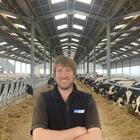Report Synopsis
The Utilisation and Impact of Robotics on Large Scale Dairying
Dairy farms are having more issues than ever sourcing labour. The biggest issue observed in my travels was attracting milking technicians into the industry. As the UK moves more towards the US model of fewer farms of a greater size, this problem is only going to be exacerbated here in the UK.
The aims of this study were threefold:
- Is robotics a viable option for large dairy farms?
- Are they a financially viable option?
- If so, what is best practice when designing layouts and utilising robotics?
During my study I visited the USA, Canada, Chile, Argentina, the Netherlands, and Germany. All countries are either at the forefront of robotics or major players in large scale dairying.
Operating box stall robots result in an increase in milk yield of between 3% and 10%, depending on the previous system. Evidence from these farms shows a reduction in replacement rate of up to 5%. Both these efficiency savings combined with a labour saving of up to 40% on large farms result in a net financial gain after robotic implementation.
Many different layouts and configurations exist for box stall robots. The most efficient system observed on my travels was a ‘milk first’ guided traffic system. Where cows are ‘guided’ around the system by the removal and presentation of certain inputs at certain times. These systems appear to result in lower pellet usage within the robot, a lower rate of fetch cows and allow a greater number of cows per robot due to preselection of certain cows.
Robot depreciation has in the past been a factor in the lack of uptake of the technology. However, there is a strong second-hand market for robots and diverse ways of financing exist to keep costs under control. Maintenance and servicing are key to extending the life of robots, with many reported as exceeding 10 years in operation.
Other robotic technologies such as feed pushers and manure collectors are more difficult to financially justify. They also still struggle to handle sand-laden manure which is often present on large dairy farms. Fully robotic rotary development appears to have stalled, with a greater emphasis now on utilising robotic arms on conventional rotary parlours.
The conclusions I have drawn from my study are that utilising robotics on a large scale is financially viable due to an increase in milk yield, a decrease in staffing costs and a reduction in replacement rates. To ensure optimal functionality, the equipment must be maintained and serviced to a high standard. Farmers should be thinking as to how robots will integrate into their businesses in the future, even if they do not plan to use them initially.
Ali Cook

The MacRobert Trust

Similar Reports
- 2023
What's the beef? Opportunities for beef on dairy in New Zealand.
Matt Iremonger - 2023
The world of cacao
Linda Kopczinski - 2022
Opportunities to make Australia’s northern beef industry more productive and resilient
Munro Hardy - 2022
New Zealand Dairy Trade And Market Expansion Opportunities.
Parmindar Singh
